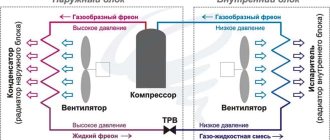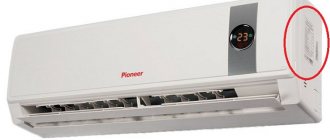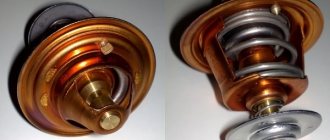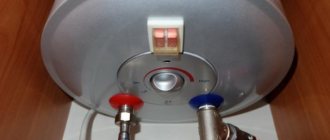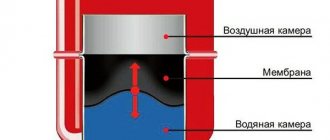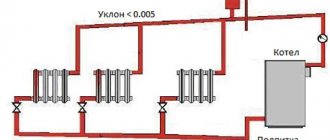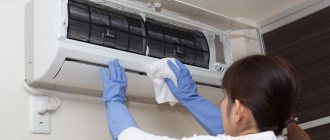Step-by-step instructions: how to refill the air conditioner
In order to independently refuel air conditioning equipment, you will need some devices, namely: digital scales, a digital thermometer, a pressure manifold and a set of hex keys.
You can use either a two- or four-position manifold. The two-position device allows you to both vacuum and charge climate control equipment, but the hose of the additional equipment will have to be reconnected, and the resulting air lock will have to be released by opening the liquid valve on the manifold. There is no need to do this with a four-position manifold. The advantage of such a device is that the system is completely sealed and there is no contact with air.
- Before starting work, you should open the locks located in the service fittings of the climate system in order to release the remaining freon in the device.
- After all the gas has left the air conditioner being refilled, the locks must be closed.
This section suggests how to charge an air conditioner with freon using the overheating indicator method. Overheating is the temperature difference between superheated steam and the boiling point of freon. When the device is turned on, the first indicator is taken using an electronic thermometer attached to the gas pipe of the device. The boiling point of the gas can be determined by the low pressure gauge on the manifold. The difference between these indicators should be from 5 C° to 8 C°. If the difference is more than 8C°, this means that there is not enough freon in the split system and it needs to be refilled.
- To refill, you need to take a scale and place a cylinder of freon on it. Then you need to set the weight indicator to “0” on the scales.
- After performing these procedures, you should open the valve on the cylinder and open the liquid valve on the manifold for one second in order to release the air that was in the hoses.
- Next, you need to open the gas valve on the manifold. During the refueling process, the pressure in the system will increase and the temperature on the thermometer will drop.
- This must be done until the temperature difference between the pressure gauge and the thermometer attached to the gas pipe of the air conditioner is 5C° - 8C°. After which you need to first close the gas valve on the manifold, and then on the freon cylinder. You can find out how much gas has been used by simply looking at the scale.
You can check the operation of the device only by connecting the device to the main line and turning it on. The main indicator of insufficient refueling is freezing of the taps; if this does not happen, then the air conditioner is filled correctly, with the required amount of gas.
Charging technology based on refrigerant weight
The essence of the method is to completely replace freon - the old gas must be released into the atmosphere, and fresh freon must be filled in instead. For beginners, this is the most acceptable option - only an experienced technician is able to determine the remaining refrigerant in the system and accurately refill the missing amount. We will describe other download methods below.
Connecting the manifold to the ports of the external module
Advice. Before refueling, correct the problem that caused the loss of old gas. Ideally, a split system should undergo a pressure test with nitrogen pumped under the maximum pressure specified in the product data sheet (usually 25-30 Bar).
We present instructions on how to charge an air conditioner with freon using a scale:
- Drain the old refrigerant into the atmosphere in any convenient way - through an unscrewed tube or spool of the service port. Release the gas slowly so as not to lose oil. While emptying, use the hexagon to open both taps hidden under the protective nuts.
- Close the taps and connect the left hose of the pressure gauge station (blue) to the spool. Make sure the manifold valves are also closed.
Connection diagram for vacuum - Connect the yellow middle hose to the vacuum pump fitting and start the unit. Open the left low pressure valve (on the left in the diagram) and watch the vacuum gauge - the arrow should fall below zero and show a value of minus 1 bar. Also open the service port valves.
- Evacuate the freon circuit for 20 minutes. After stopping the pump, wait half an hour while watching the pressure gauge. If the needle moves back to zero, look for a leak.
- Switch the hose from the pump to the cylinder, close the left valve of the manifold. Open the tank valve a few turns and purge the hose with freon. The operation is simple: open the right valve of the station (high pressure) for 1 second.
The filling vessel is connected with the same hose as the vacuum pump - Place the cylinder on the scale properly and reset the display to zero. Open the left manifold valve again and monitor the decrease in gas mass. When the display shows the required amount of refrigerant, close the tap.
- Close both valves on the service ports, disconnect the pipe from the spool and check the split system for operation.
Standard R410 refrigerant container must be inverted
Important point. Freon R410a is poured only in a liquid state, so the cylinder is placed on the scale upside down. During refueling, the flow of substance can be easily seen in the manifold inspection window. If the tank is equipped with a siphon or R22 refrigerant is pumped in, there is no need to turn the tank over.
During operation, it is important not to confuse the sequence of operations and not accidentally open the filled circuit. The minimum evacuation time is 20 minutes; during this period, the pump will remove not only air from the system, but also moisture that can harm the compressor. How to refill an air conditioner with R410a freon, watch the video:
Types of refrigerant
Freon is used as a refrigerant in air conditioners. It is a cooling system for the compressor and protects it from overheating. Freon leaks are caused by improper installation of equipment and its malfunction. There is also a normalized freon consumption during the service period, it is up to 9% per year. There is no normalized leakage for window and mobile air conditioners.
There are several types of freon that can be used if you need to refill or top up your air conditioner. These include:
Freon R22
- Freon R22 (freon 22) is a refrigerant that is used in cooling systems to very low temperatures. These include various refrigerators for industrial and household use, automobile and marine refrigerators, household and industrial air conditioners. If there is a leak of this freon, its vapors evaporate gradually. The positive aspects of this type of freon are the relatively low cost of devices that are filled with R22, and service components for them. Devices with such freon can be partially charged without using a full charge. The R22 refrigerant has only one drawback - it negatively affects the ozone layer of the earth and therefore is not recommended for use by environmentalists;
- freon R410A – has absolutely no chlorine and, therefore, does not destroy the ozone layer of the atmosphere. This is a newer generation of refrigerant that replaced R22 freon. It quickly gained popularity and is successfully used for refilling refrigeration equipment for household and industrial purposes, as well as various air conditioners. Freon 410 consists of two different components. With a leak of more than 40%, a complete recharge of the device is necessary. Adding freon to a system in which a leak of more than 40% has occurred will lead to unstable operation of the equipment, as a result of which the relationship of the freon components to each other will be disrupted;
- freon R-407c – contains three types of freons, each of which is responsible for its own function in operation. R32 is responsible for good performance of the entire system, R125 is responsible for fire safety, R134a stabilizes the overall pressure in the working circuit. If there is any leakage of this type of refrigerant, its components evaporate unevenly, so such air conditioners cannot be refilled. It is necessary to completely drain all the freon and refill it.
Principle of operation
A car air conditioner consists of several elements:
- A compressor that ensures constant circulation of freon throughout the cooling system circuit;
- Condenser - heat exchanger. In this unit, freon vapor accumulates and condenses with further heat release;
- An evaporator acting as a heat exchanger. It is in it that the evaporation of liquid freon and the removal of heat occurs;
- Receiver-dryer, through which the refrigerant is cleaned and dried;
- Pipelines;
- Expansion valve;
- Cooling fan;
- Automation systems (fuses, sensors, etc.).
Essentially, a car air conditioner has three main elements - a compressor, an evaporator and a condenser. All other details play a supporting role.
The system works according to the following principle.
Freon is in a closed circuit. Under the action of the compressor, the refrigerant is heated and sent further through the system under pressure.
On its way there is a condenser, where the refrigerant is cooled and converted into liquefied gas.
After this, the freon enters the receiver-dryer, which filters out dirt and debris.
The refrigerant then passes through numerous pipes in the system and flows to the expansion valve.
After cooling, the freon is sent to the evaporator (located directly inside the car) and enters the passenger compartment. The refrigerant is then sent to the compressor.
That's it - the cycle is closed. By the way, in addition to its cooling function, the evaporator also effectively dehumidifies the air.
Preventative work. What you need to know
To fill a split system with freon, you need to have a certain set of knowledge.
Firstly, refrigerants consist of substances that are safe for human health. When working with them, no special instructions are required. They are commercially available in cylinders of a certain capacity.
Secondly, you need to know that charging and refilling today is usually carried out with two types of refrigerant - R407C or R410A. The first variety is a mixture of three types of freon. If a system filled with such a refrigerant depressurizes, refilling is impossible - complete disposal of the remnants of the substance will be required and refilling with a new one. The second type of refrigerant is a modern development, it is environmentally friendly, and the air conditioning system can be refilled if necessary.
The entire result of the procedure for filling a split system with refrigerant can be affected by the choice of the brand of working substance. By giving preference to a cheaper refrigerant, the owner of a split system risks causing the compressor to break down. And this will entail much more serious costs.
Thirdly, there are several methods for charging the system with refrigerant. Before you begin practical actions, you need to thoroughly study the theory of the question of how to refuel a split system yourself, and choose the most appropriate method.
- Refueling based on pressure. To use this method, you will need information about the permissible amount of working substance in the system. They are provided by the manufacturer in accompanying documents or on the official website. Through a pressure gauge, the gas cylinder is connected to communication tubes. Freon is served in small portions. The device's performance is regularly compared with the recommended data from the air conditioner manufacturer. The described actions are carried out until the correspondence of the numerical indicators is achieved. The technique requires the ability to use instruments, and the procedure itself takes quite a lot of time.
- Charging based on the mass of the refrigerant. When using this method, continuous monitoring of the mass of the container with freon is necessary. Any scale that is easy to use will be suitable for this procedure. The essence of the method is that freon from the cylinder must flow into the unit. By tracking how much lighter the container with the contents has become than the original indicator, one can judge the filling level of the system. The simplicity of the method is its main advantage. But there is one point that may cause difficulty. The fact is that before refilling, the system must be freed from refrigerant residues and all impurities contained there must be removed with a vacuum pump.
- Using the filling cylinder. This method is used when the exact freon content in the system is known. The missing amount of the substance is placed in a cylinder, from which it must be delivered to the unit. The advantages of the method are that there is no need to evacuate the remaining freon from the air conditioning system and carry out evacuation.
- Refueling due to overheating or hypothermia. The purpose of the actions during the procedure is to record the temperature difference. Of all the proposed methods, this is the most complex.
Each of the existing methods has its positive and negative sides, and none of the methods can be called universal. To refuel the split system yourself and choose the right method, you need to take into account many factors. It is for this reason that refilling the air conditioner with refrigerant is individual.
Preparatory work
Before refilling your car air conditioner, you must clearly determine the required type and volume of refrigerant. Everything is simple here.
If your car was manufactured before 1992, then you should use the R-12 type of freon.
Since 1993, car manufacturers have been pumping in R-134a freon. The reason is a banal ban on the use of R-12.
Difficulties may arise only for owners of cars produced in 1992-1993, because during the transition period, not all manufacturers immediately switched to R-134a.
To find out more accurate information, carefully study the sticker on the inside of the hood (this data is usually indicated there).
The second option is that you can recognize the type of freon by the fitting. In new models of car air conditioners that operate on R-134a, the fitting has a larger height and diameter.
As for the refrigerant charging standards, they are indicated on the plate that we talked about above.
In addition, this information can be obtained from a specialist or in the operating instructions.
On average, the norm for domestic cars is about 500-1000 grams.
History of origin
The desire to get cool, fresh air in his home prompted man to create an air conditioner. But the appearance of this device was preceded by a long history of attempts to create a universal device for monitoring the state of the environment.
Humanity has noticed that cool and fresh air always appears near water. This is how the first prerequisites for the invention appeared. Scientists of ancient Persia invented ventilation shafts, at the bottom of which lay material that absorbed moisture, air evaporation, and groundwater. The air thus humidified entered the houses.
Europe in the 19th century was famous for its attempts to humidify the air using ice plants. Thus, the English scientist W. Whiteley connected a cavity with ice and a fan. The air passed through the ice and thereby cooled.
Is it possible to charge the air conditioner yourself, and what do you need for this? (+video review of the refueling kit)
Yes, you can - the work is not difficult.
But it is unprofitable: freon is usually sold in large cylinders, and in addition to it, you will need to buy equipment for refilling. Therefore, in most cases it is better to pay a specialist than to work yourself.
But if you still decide to do it yourself, you will need:
- Hex set (or adjustable wrench)
- Set of Phillips screwdrivers.
- Digital scales (with a range of up to 15-20 kg).
- Pressure manifold (station). This is a measuring tool that controls the pressure in a split system. You can use a two- or four-position device. Four-position - more convenient and reliable. Cheap installation costs from 2600-2800 rubles.
- A freon cylinder of a suitable brand.
Methods for refilling an air conditioner with freon
connecting a pressure gauge to the outdoor unit
There are several basic methods for charging refrigeration systems with freon, applied to home air conditioners (splits), multi-splits, mobile and multi-zone systems.
Refilling the air conditioner with your own hands will require the following kit:
- pressure gauge;
- Vacuum pump;
- freon cylinder;
- construction scales;
- locksmith tools - Swedish key, hexagons, screwdriver.
Refueling by scale
construction filling scales
If you need to fill a completely empty air conditioner with 22 or 410 gas, then the process occurs as follows.
Vacuuming. Screw the pressure gauge onto the shredders and open the tap. Turn on the vacuum pump and wait 10 minutes. Close the tap on the pressure gauge and turn off the pump.
Connecting a freon cylinder. The container with gas is turned upside down and placed on a scale, the readings of which are first reset to zero. Open the tap on the pressure gauge and pour in the required amount of refrigerant according to the scale.
Close the tap and disconnect the pressure gauge, after which the caps on the ports are screwed on. Turn on the air conditioner and check its functionality.
This method is considered the most correct, but it is complicated by the need to have expensive scales for weighing freon.
If you want to fill the air conditioner 410 with freon yourself, then first completely bleed off its remains into a pressure gauge station for collection, and then pour in the gas according to the scales. This is due to the fact that this type of freon consists of a mixture of various gases with varying degrees of volatility. If one of the components leaks in a larger volume, the composition changes, and, consequently, the necessary properties of the refrigerant are lost.
If you need to fill the air conditioner with R22 freon, then they resort to the following method: filling the air conditioner by pressure.
Filling by pressure
First you need to connect the pressure gauge to the gas port of the air conditioner operating for cooling. The operating pressure of the device should be 3-3.5 atm. If it is below these marks, then refueling is required. To do this, connect a cylinder with freon and begin to fill it into the system in small portions by opening the taps on the pressure gauge for 5-10 seconds.
To avoid burning your hands with gas, it is more convenient to use quick-release connections.
Refueling for overheating and hypothermia
non-contact infrared thermometer for climate control equipment
A fairly accurate method is to refill the air conditioner based on overheating or overcooling. The whole point is to focus on the temperature difference.
In the case of supercooling, we mean the ratio of the temperature indicators of liquid and condensation at the same pressure. The condensation temperature can be determined as follows: its pressure is measured with a manometer, and then the data is correlated with the scale values of the manometric manifold depending on the refrigerant. To determine overheating, the temperature values of the gas in the normal state and when it boils under conditions of the same pressure are compared.
A refrigerant leak and the need to refill it are indicated by overheating above normal and subcooling below normal.
A non-professional is unlikely to be able to refill the air conditioner with his own hands using these two methods, as they require a sufficient knowledge base in the field of air conditioning systems. Although the ease and accessibility of previous methods for the common man is also a controversial issue.
Refueling the air conditioner using current
current clamps
Many craftsmen do not use this method, but its use is quite justified in cases where it is not possible to use scales to weigh freon. So how to charge the air conditioner yourself using current?
To determine the operating current of the compressor, you will need special current clamps, which are applied to the phase of the power wire of the operating external unit. If the values obtained are lower than those indicated in the manual or on the nameplate, and the pipe is frozen, then refill with freon until the indicators level out.
All other stages completely coincide with the stages of filling the air conditioner with freon using scales, which can be viewed in the video at the end of the article.
This method is also applicable in the case of eliminating the consequences of leaks in semi-industrial equipment.
What should you refill the air conditioner with and how much substance is needed?
Like refrigerators, air conditioners are charged with freon, but the freon in the air conditioner is special, intended only for this type of equipment. Typically the type of stamps used.
Most often, 2 types of freon are used to refill the air conditioner:
- R-22 is a reliable refrigerant with high cooling efficiency, which sets it apart from other types. When using this type of substance, energy consumption increases, but the air conditioner starts working and cools the room faster. Its substitute, R407c, is also suitable. This type of refrigerant contains chlorine.
- R-134 a is a new type of freon that does not harm the environment, does not contain impurities and is also characterized by high cooling efficiency. However, its cost is high, so this refrigerant is rarely used. This type of freon is often used to refuel a car.
- R-410A is an ozone-safe freon.
The following charging methods are available:
- Refueling by weight. In this case, you need to weigh the cylinder with freon and calculate the required amount that must enter the system for normal operation of the air conditioner. But this will require the use of special scales, as well as vacuuming inside the equipment.
- Pressure filling. This requires a manifold. In this case, you need to know the technical features specified in the equipment passport, and freon is introduced in small portions to control the process of filling the equipment.
There is another way - refueling using temperature differences, but this is carried out only by professionals.
After installing the equipment, manufacturers usually charge the device based on the standard length of the pumping route; the amount of refrigerant required is usually indicated in the technical documentation of each air conditioner. The data plate is usually located on the outside unit housing or on the air conditioner's protective cover.
It is not necessary to calculate the exact amount of freon; it is enough to know the approximate value. For example, the average length of the route is from 3 to 5 m, and when refueling equipment with a power of up to 2 kW, it will be necessary to use about 90 grams of refrigerant. If the device power is 8-10 kW, about 600 grams of freon will be required.
Important! If the pumping route is longer, then 15 grams of refrigerant should be added for every meter of its length.
Refilling the air conditioner with freon
Refueling
The main reason for the breakdown of floor-standing air conditioners is untimely refilling or its absence at all. The fact is that the device uses freon gas as a refrigerant, which is subject to evaporation. Thus, refrigerant typically loses 10% of its mass over the course of a year. Also during operation there is a natural leakage of freon. Therefore, each consumer must be able to refuel a mobile air conditioner himself and carry out this procedure periodically.
Signs of low refrigerant:
- Slow operating speed
- Poor quality of work
- Presence of extraneous noise
- Increased electricity consumption
- The appearance of frost on the device body
- Icing of the air duct pipe
The appearance of one or more signs during operation indicates the need for a refueling procedure.
Before refilling a mobile air conditioner with freon, you should know the main features of refilling floor-standing air conditioners:
- The design of the device involves the use of components in a single housing. Manufacturers provide complete sealing of the system, so the body of the device is subjected to a soldering procedure. The manufacturer fills the device with freon, after which refilling is not provided. However, any air conditioner is susceptible to refrigerant leakage, so it needs to be filled with freon. Refilling is carried out using a special Schrader valve mounted in the device, through which freon is supplied.
- The manufacturing features of floor-standing air conditioners imply only the procedure for fully charging the device, i.e. Partial refueling is not suitable in this case.
- Mobile air conditioners use freon type R22 and R407C - in more modern devices. R407С is a three-component gas of complex composition. In the event of a leak, only part of its components is lost, so it is impossible to refill this type of refrigerant. A full refueling procedure is required.
You can perform the procedure for refilling a mobile air conditioner yourself. To do this, it is recommended to follow the basic rules. It is necessary to read the instructions for refilling mobile air conditioners.
Final check and troubleshooting
Now all that remains is to turn on the car air conditioner and check its operation. Here pay attention to the following points:
- make sure that within a few seconds after turning on the air conditioner, cold air begins to flow into the cabin;
- inspect the entire system for freon leaks;
- if you suspect a leak, you can re-check (we discussed the technology above);
- listen to the operation of the compressor; if there are extraneous noises, this may indicate wear of parts or internal damage to the unit. Often the cause of noise is a faulty bearing, as a result this can lead to failure and repair of the compressor;
- Clean air should come out of the system, without any unnecessary odor. Otherwise, replace the cabin filter.
Who does this and how much does the service cost?
Look for companies in your city that service climate control equipment - they can also replace the refrigerant or refill the system.
How much does such a service cost approximately (for a seven or nine class home air conditioner):
- refueling: from 1500 rubles;
- complete replacement: from 2500 rubles.
More precisely, only the master will tell you the cost. The price depends on:
- quantity and brand of refrigerant in your split system;
- condition of the air conditioner (if there is a leak, there is no point in refilling the refrigerant right away: it will leak again - so first diagnostics, repairs are carried out, and only then refilling).
What freon is used in household air conditioners (+ price of cylinders)?
There are about 40 different types of freons.
The following brands of refrigerants are used in domestic (home) air conditioners:
- R-407C. It is impossible to refill an air conditioner with such a refrigerant, since if it leaks, it changes its composition and loses its characteristics. Therefore, such split systems are only completely refilled (the old freon must be drained and then refilled with new one). An 11.3 kg cylinder costs about 6,500 rubles.
- R-410A. Unlike R-407C, it does not lose characteristics when leaked. Therefore, systems with this refrigerant can be topped up. A cylinder weighing 11.3 kg costs about 8,000 rubles.
- R32. In terms of thermal conductivity and performance - 5% more efficient than R-410A. It also does not need a complete replacement - if there is a leak, the system can be topped up without draining all the refrigerant. A cylinder weighing 10 kg costs about 8000-8500 rubles.
- R22. Since 2010, this refrigerant has been banned in the USA and Europe, since 2015 - in the Russian Federation (since it harms the ozone layer of the Earth). If you have an old split system, it can still work on this freon. New ones are already produced on other brands. Systems with R22 refrigerant can be filled with R-407C.
Prices are approximate, current as of March 2021 (at an exchange rate of 66 rubles per $1).
How can I find out the brand of freon in my air conditioner?
You can find out which freon is poured into the system in the following ways:
- Check the paper instructions for the air conditioner if you still have them.
- Look at the name of your model (on the plate on the side of the indoor unit, or in the instructions), and google the refrigerant characteristics.
- On the internal unit of the split system (which is installed indoors) there is a table with characteristics on the side. The type of freon is written there (Refrigerant).
Location of the table with characteristics on the indoor unit
How much freon is in the air conditioner, and how to calculate the amount depending on the length of the route?
Different air conditioners are charged with different amounts (volume) of refrigerant.
Table of standard indicators:
| Power class | Cooling capacity, kW | Approximate amount of refrigerant, grams |
| 7 | 2-2.2 | 500-750 |
| 9 | 2.5-2.8 | 600-750 |
| 12 | 3.3-3.6 | 800-900 |
| 18 | 5-5.4 | 1100-1200 |
| 24 | 6-6.4 | 1400-1700 |
This is for a standard route length. The length of the route will differ for different manufacturers and for air conditioners of different classes. On average - from 3 to 7 meters for models more powerful than 12. For 7-9 - the routes can be shorter. Exact data is indicated in the instructions for each model.
If the route is longer, more freon will be needed. For each extra 1 m we add 15-20 g for models of grades 7-9, and 20-30 g for 12-24.
Do-it-yourself refilling of a household air conditioner
Refilling an air conditioner with your own hands is a rather difficult task, so if possible, it is advisable to call in specialists. If you are determined to act on your own, stock up on all the necessary attributes and patience. The most important thing is to choose the right brand of refrigerant and listen to the advice of experts. But first, figure out why you needed refueling.
Why is the amount of refrigerant in the system decreasing?
Even with proper installation and operation, the amount of freon in the air conditioner gradually decreases. Usually part of it is lost through copper tubes located between the external and internal units. This happens very slowly, so refueling is rarely required.
It's another matter if the tubes were damaged. For example, when transporting or installing an air conditioner in a new place. No amount of refilling will help here if the cause of the leak is not eliminated.
Signs of low refrigerant in the system:
- the room is almost not cooled or cooled poorly;
- Frost has appeared on the external unit of the air conditioner.
Important: if you do not refill the air conditioner on time, it will not only begin to work worse, but also overheat, which will soon lead to its breakdown
Selecting refrigerant for refilling
The refrigerant used in an air conditioner is different from that used in a refrigerator. R-22 freon has proven itself best of all: it is what specialists use when working with modern split systems. If you take R-8 or any other type of freon, the efficiency of your air conditioner can drop significantly, which will lead to an increase in energy bills.
There is also freon R-134a, which does not destroy the ozone layer and is considered safer for the environment. However, this refrigerant is not widely used due to its high cost.
Remember that freon is an absolutely safe gas for humans, so you can safely work with it at home.
Refilling the air conditioner
- Set the temperature to 18 degrees and turn the device on cold.
- Find the largest tube from the outdoor unit.
- Open the cap and use a special hose to connect a pressure gauge there (the other end is connected to a cylinder with freon).
- Set the normal speed of the split system and start measuring the air temperature using a thermometer or digital sensor.
- Open and close the valve of the gas cylinder a little at a time, carefully monitoring the instrument readings. The temperature must rise and the pressure in the system must increase.
- It is necessary to bring the pressure to 5-7 bar (depending on the outside temperature: the higher it is, the greater the pressure should be).
- As soon as frost appears on the valves (nuts) and pressure gauge, the process must be stopped.
- Disconnect the cylinder with the pressure gauge and put the cap back in place.
A properly charged air conditioner will work well, consuming as much electricity as stated by the manufacturer. At the same time, it is bad for the system if there is a shortage of refrigerant and its refilling.
Experts calculate the pressure, temperature and amount of freon required using special formulas. That is why, if you act on your own, without having an idea about all this, you can damage the device. Don't take risks - call a trusted specialist!
When to refuel
You must definitely pump freon into your home air conditioner in one of the following cases:
- Once every two years, provided that the system is installed correctly;
- After the cooling system has been installed for the first time or has been moved to a new location;
- If the freon lines were disconnected for some time, for example, after repairs;
- In case a leak occurs.
Important! The main sign that the freon needs to be changed is when the device itself no longer cools properly.
Freon replacement in 80% of all cases is required immediately after installation. This usually occurs due to errors made in the installation system. Carefully check the system directly in front of the specialists. This way you will avoid unnecessary costs for changing freon.
Window-type cooling systems practically do not require refilling. They usually have short tubes located at the end of the housing, which are almost impossible to touch during installation.
How to check for air conditioner leaks Source ytimg.com
A freon leak can be detected by one of the following signs:
- Frost began to form on the external unit;
- at the same temperature and standard settings, cooling occurs more slowly or does not occur at all;
- When you turn on the air conditioner, an unpleasant odor appears;
- the air conditioner turns off on its own or shows an error code (this usually happens on inverter models).
See also: Catalog of companies that specialize in complex installation of internal engineering systems
Description of the procedure
You can charge the air conditioner at home yourself if you have all the necessary tools and equipment. It is advisable to prepare them all in advance. It is worth noting that if you refuel the system yourself, it is absolutely not necessary to purchase a pressure gauge device. You can always rent it from a special company. The stages of filling the system with freon are as follows.
- Radiator blocks are being cleaned. After this, the fans will definitely work correctly.
- Next, freon is produced. For this procedure there are special locks in the service fittings. They must be opened, and after all the substance has come out, the locks must be closed.
- The refrigerant cylinder is placed on the scales, and the scales are set to zero. Then the valve on the device quickly opens to drain excess air from the hose.
- The air conditioner sets the temperature at 18 degrees. It should work for cooling.
- After this, a pressure gauge device is attached in place of the largest tube coming from the external unit of the split system.
- Also, the pressure gauge device is attached to the freon cylinder.
- The valve responsible for the gas supply opens on the manifold. During the process, there will be an increase in pressure and a decrease in temperature in the system. It is optimal if the pressure increases to 6-7 bar.
- Then the gas supply valve and the valve on the cylinder are closed.
You can calculate the volume of refrigerant needed to charge the system by weighing the cylinder again.
For information on how to refill the air conditioner yourself, see below.
Good day everyone! Today in the article we will talk about refilling the split system. During its operation or immediately after poor-quality installation, you can detect a lack of refrigerant (freon) in the system. If the cause of the leak is a manufacturing defect (leaking of the radiator of the indoor or outdoor unit), then this usually manifests itself during the installation of the device. If no manufacturing defects are identified, then there are only two main causes of leakage:
- the first reason is installation errors (approximately 80% of leakage cases). Most often this is due to poor quality rolling of copper tubes. In this case, it is necessary to find and eliminate the cause of the leak before refueling the Conder;
- the second reason is natural leakage (so to speak). Although, according to theory, the freon circuit should be sealed. Even in expensive models, a slight escape of refrigerant through connections and service taps cannot be ruled out.
The process of recharging the air conditioner with refrigerant is short, but requires care, caution and understanding of the entire process. The slightest mistakes when “pumping” freon can lead to serious damage to the split system
And you may get hurt yourself. Therefore, I EXTREMELY DO NOT ADVISE PERFORMING THIS OPERATION BY YOURSELF WITHOUT THE SKILLS OF AN AIR CONDITIONER.
Diagnostics after refueling
After pumping freon into the air conditioner, turn it on and carefully observe the operation of the system for a couple of hours. Refilling could lead to abnormal operation of the device.
If you have over-solded by no more than 10%, then this will not be a major problem. This will not affect work. Overfilling more than this value will negatively affect the operation of the compressor and may lead to breakdown.
If you have changed the freon, but the device still works poorly, then it is worth checking the pressure. You may have added below the required level. If the freon level is normal, but the air conditioner does not cool properly, then it is worth checking the device itself. Most likely the problem is somewhere else.
Dismantling the air conditioner step by step
Disassembly while maintaining the functionality of the dismantled air conditioner is as follows:
- sealing of pipeline fittings;
- disconnecting and dismantling the external unit from the facade;
- dismantling the indoor unit in the apartment.
Below are instructions for dismantling a wall-mounted air conditioner.
Outdoor unit
To remove the outdoor unit of the air conditioner, first disconnect the tubes.
Dismantling the outdoor unit
There are two ways:
- Unscrew the union nuts that press the flared edges of the tubes to the flanges of the fittings of the outdoor unit. And in place of the nuts, pre-prepared caps are screwed on. The advantage is that the tubes remain intact. The disadvantage is that there is a high risk of air getting into the compressor.
- Side cutters are used to cut copper tubes (about 15 cm from the fitting). The edges are folded and clamped (caulked) using a vice. The disadvantage is that new tubes must be installed in a new place. The advantage is that the operation is quick and the likelihood of dust getting inside with air is much lower.
Note. The other cut edge of the tube must also be caulked to protect the evaporator of the indoor unit.
The next step is to disconnect the cables (signal and power), remove the fastenings of the unit to the frame on the outer wall and lift it into the room.
Compressor
One of the situations when it is necessary to remove the outdoor unit may be to replace the air conditioning compressor. And in this case, the dismantling algorithm is slightly different. The differences are as follows:
- Freon must be completely removed from the system. The correct way is to collect it in a cylinder using a freon pumping station. Incorrect, but simple - release it into the atmosphere (if the compressor is replaced in the warm season and the air temperature is higher than the boiling point of freon at normal pressure).
- There is no need to caulk the tubes - after installing a new compressor, the system is “pumped out” with an external vacuum pump.
It is impossible for a non-specialist to replace the air conditioning compressor on his own. In addition to the vacuum pump and pressure gauge station, it is necessary to have a gas burner to disconnect the suction and outlet pipes of the old compressor from the system, and then solder the new unit to the system. And even if you rent equipment, you need to have the skills to handle it.
You can remove the unit yourself, but it is better to invite a professional to replace the compressor.
Indoor unit
Most household split systems have a wall-mounted indoor unit (although there are other placement options). But with the exception of a ducted air conditioner, the remaining types are dismantled according to the general principle.
To remove the internal wall unit, proceed as follows:
- remove the housing cover;
- disconnect cables and wires;
- cut and caulk the copper tubes that go to the evaporator of the indoor unit;
- cut off the drainage pipe and drain the condensate;
- “snap off” the latches securing the housing to the mounting plate;
- remove the block and unscrew the plate from the wall.
Repairing the leak
If the damage is significant or an entire system unit has failed, then it is better to contact professionals for repairs.
But most often the damage to the air conditioner is minor. Therefore, you can carry out restoration work yourself.
There are two options here.
Using a special patch.
Here the sequence is as follows:
- prepare a small metal tube that fits the diameter;
- place small clamps on it, clean it with sandpaper and degrease it with an alcohol solution;
- connect the two halves of the coupling using regular electrical tape;
- Apply glue to the prepared coupling, place the part in place and tighten it with clamps.
As an option.
Using sealant.
Today, special products are sold that effectively heal minor damage. All that is necessary is to pump them into the system along with freon.
After 20-30 minutes, the existing cracks will disappear, and the problem with freon leakage from the car air conditioner will be eliminated.
Precautions when working with freon
If you are planning to refill the air conditioner yourself, remember:
- Brands containing chlorine are harmful to the body. Avoid contact with mucous membranes (eyes, mouth), and do not inhale them.
- If there is a high concentration of freon, you can get poisoned. Therefore, do not work indoors - be sure to open the window and door, and if there is one, turn on the hood (in the kitchen and bathroom).
- If liquid freon gets on your skin, you can get frostbite. Therefore, you only need to work in rubber gloves and closed clothing (not a T-shirt or a T-shirt with shorts).
If during operation the coolant gets on the skin or mucous membranes, it should be immediately washed off with water and the area should be lubricated with Vaseline.
If symptoms of suffocation or any other abnormal signs occur, you must immediately stop working, leave the room and ventilate it.
How to clean an air conditioner: step-by-step instructions for cleaning it yourself
Why can an air conditioner gurgle, why is it dangerous and what should I do?
